







Lighting accuracy is critical in today’s residential, commercial and industrial markets.
This is measured and quantified using the Color Rendering Index (CRI), which is the industry standard for measuring a particular light’s accuracy.
CRI runs on a scale going up to 100, which is the CRI of a black body radiator reference light.
This reference light is either an incandescent type artificial light or natural sunlight, which are the most accurate light sources available.
It is worth noting that CRI is independent of Correlated Color Temperature (CCT), a term often used in conjunction with CRI when describing the properties of light.
CCT measures the actual color of the light produced in Kelvins and does not have anything to do with the light’s illumination accuracy.
A color rendering index (CRI) is a quantitative measure of the ability of a light source to reveal the colors of various objects faithfully in comparison with a natural or standard light source.
Light sources with a high CRI are desirable in color-critical applications such as neonatal care and art restoration.
It is defined by the International Commission on Illumination (CIE) as follows:
Color rendering: Effect of an illuminant on the color appearance of objects by conscious or subconscious comparison with their color appearance under a reference or standard illuminant.
The CRI of a light source does not indicate the apparent color of the light source; that information is given by the correlated color temperature (CCT).
The CRI is determined by the light source’s spectrum. An incandescent lamp has a continuous spectrum; a fluorescent lamp has a discrete line spectrum, implying that the incandescent lamp has a higher CRI.
The value often quoted as “CRI” on commercially available lighting products is appropriately called the CIE Ra value, “CRI” being a general term and CIE Ra being the international standard color rendering index.
Numerically, the highest possible CIE Ra value is 100 and would only be given to a source whose spectrum is identical to the spectrum of daylight, very close to that of a black body (incandescent lamps are effectively black bodies), dropping to negative values for some light sources.
Low-pressure sodium lighting has a negative CRI; fluorescent lights range from about 50 for the basic types, up to about 98 for the best multi-phosphor type.
Typical white-color LEDs have a CRI of 80, 90, or more.
The visible part of the electromagnetic spectrum is composed of radiation with wavelengths from approximately 400 to 750 nanometers.
The blue part of the visible spectrum is the shorter wavelength, and the red part is the longer wavelength with all color gradations in between.
Spectral power distribution graphs show the relative power of wavelengths across the visible spectrum for a given light source.
These graphs also reveal the ability of a light source to render all or selected colors.
Below see how a typical spectral power distribution graph for daylight.
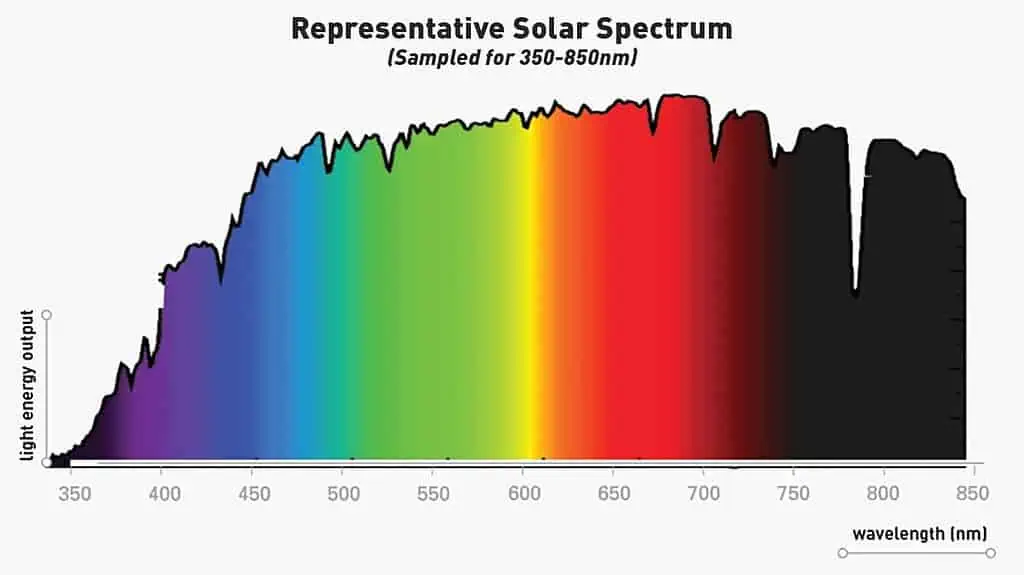
Notice the strong presence (high relative power) of ALL wavelengths (or the “full-color spectrum”).
Daylight provides the highest level of color rendering across the spectrum.
Compare the daylight spectral power distribution with that of a LED light.
The most obvious difference is the generally lower level of relative power compared to daylight – except for a few spikes.
All wavelengths (the full spectrum) are again present but only certain wavelengths (the spikes) are strongly present.
These spikes indicate which parts of the color spectrum will be emphasized in the rendering of color for objects illuminated by the light source.
This lamp has a 2700K color temperature and a CRI of 82. It produces a light that is perceived as “warmer” than daylight (2700K vs. 5000K).
Its ability to render color across the spectrum is not bad, but certainly much worse than daylight.
As mentioned above, the same light color can have a different spectral composition.
Therefore, you cannot judge a light source’s CRI by simply looking at the color of the light.
It will only become evident when you shine the light onto various objects with different colors.
CRI is measured using the industry standard method developed by the CIE.
This involves the comparison of a test source’s color rendering to a reference source known as a black body radiator with a perfect CRI score of 100.
For this testing, there are fifteen primary reference samples used to calculate the general CRI rating.
The sample selected for the reference source is dependent on the color temperature of the light being tested.
The ColorChecker chart, established by CIE (1999), categorizes these reference sources and organizes them numerically starting with TCS01 and ending with TCS15.
The closer the source being tested matches with the perfect reference source, the higher it will rank in CRI.
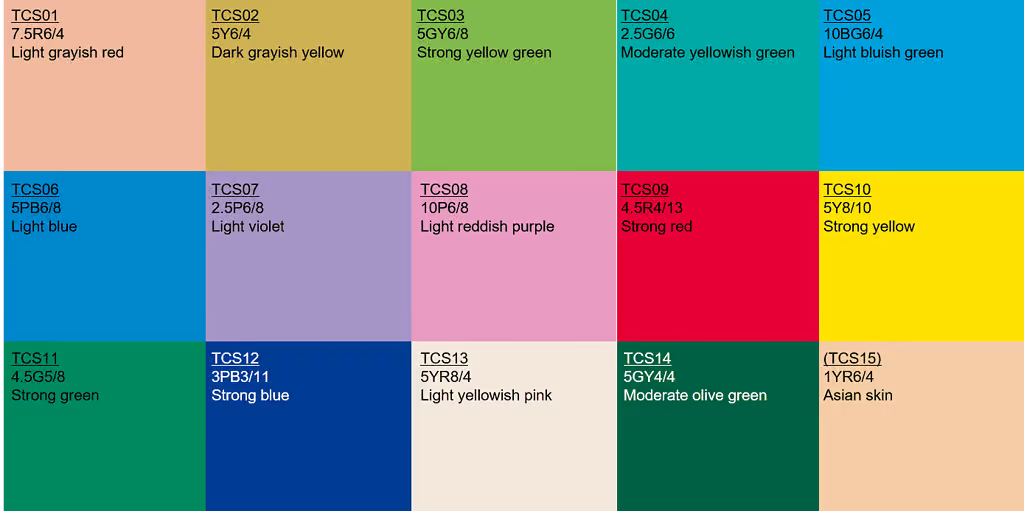
We compare the reflected colors and formulaically determine each color swatch’s “R” score.
The R value for a particular color indicates the ability of a light source to faithfully render that particular color.
Therefore, to characterize the overall color rendering capability of a light source across a variety of colors, the CRI formula takes an average of the R values.
Ra is the average value of R1 through R8.
AvgR is the average value of R1 through R15.
It should be clear now that CRI is a vital measurement for determining the performance of artificial light and is a crucial purchasing consideration in today’s lighting market. Building managers, decision-makers, and purchasers have recognized the essential benefits of using lights with higher CRI ratings.
This includes an improvement in workplace safety and the productivity and efficiency of a commercial environment.
These benefits are most noticeable, with lights having a CRI of 80 or above, suitable for general commercial and industrial purposes.
The most readily apparent benefit of lights with higher CRI ratings is the improvement in safety due to increased visibility.
Lights with lower CRI ratings, such as sodium lamps and fluorescent lights, do not accurately show true colors, making distinguishing between colors difficult.
This can affect the ability to read or notice warning labels, safety zoning, or other crucial safety-related information such as bright colors to draw attention to risks and danger. Improvements in visibility due to a higher CRI light source such as LEDs reduce these risks and the number of accidents, mistakes, and related issues.
Productivity is another benefit of higher CRI lighting, often overlooked on paper.
A workplace illuminated with high CRI lighting produces a far more pleasant environment for workers and employees.
Higher CRI ratings reduce stress, headaches, tension, depression, and eye strain and improve overall mood, which boosts productivity.
This improvement is especially notable over time due to its direct impact on a company’s bottom line and profitability.
In the retail world, lighting with a high CRI has the additional benefit of improving sales performance.
As mentioned previously, customers shopping in retail stores prefer high CRI lighting for the same reasons as employees and workers.
There is such a preference for this that retail locations that have switched to high CRI lighting have seen significant improvements in sales numbers afterward.
This is due to a more pleasurable shopping experience and the improved illumination of products, which increases their appeal.
80 CRI (Ra) is the general baseline for acceptable color rendering for most indoor and commercial lighting applications.
For applications where color appearance is essential for the work being done inside or can contribute to improved aesthetics, 90 CRI (Ra) and above can be a good starting point. Lights in this CRI range are generally considered high CRI lights.
For professional reasons, types of applications where 90 CRI (Ra) might be needed include hospitals, textile factories, printing facilities, or paint shops.
Areas where improved aesthetics could be necessary, include high-end hotels and retail stores, residences, and photography studios.
When comparing lighting products with CRI values above 90, it can be beneficial to compare the individual R values that make up the CRI score, particularly CRI R9.


